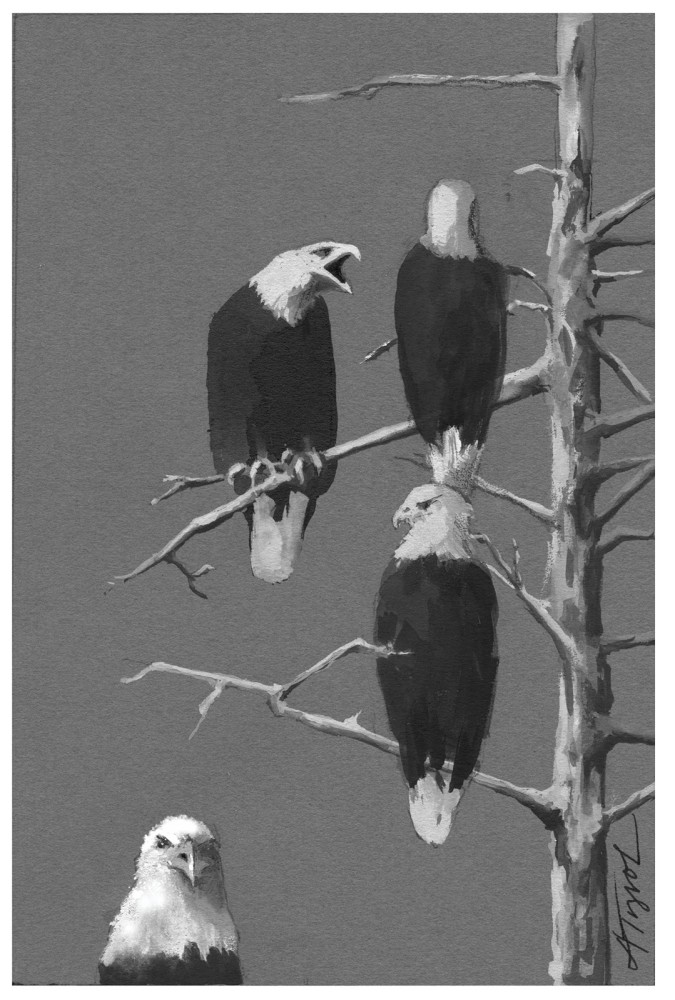
A couple of decades ago, I spent several winters living in Crested Butte, Colorado, where I learned to peer into the cottonwood trees between Route 135 and the East River on the rare occasion when I needed to travel south to the closest “big” town. There, just downstream from the local fish hatchery, I would often find a group of bald eagles perched and waiting for their dinner to swim by.
Growing up in New England, I’d never seen a bald eagle close to home – and certainly not a dozen of them in one cluster of trees. But the birds that serve as our country’s emblem have made a remarkable comeback in recent decades and are now dispersed across the United States, north into much of Canada, and south into parts of Mexico. In northern New England, adult bald eagles tend to stick around their territories throughout the winter, with younger interlopers from other areas passing through.
“We can find adult eagles near and even at their nests any month of the year,” said Chris Martin, senior biologist with New Hampshire Audubon.
Eagles don’t undergo physical changes in preparation for winter – there’s no extra layer of fat or winter growth of thick fur – but they do change their behavior enough to survive the coldest months. This includes being flexible in what they eat and giving up their mainly solitary lifestyle for a more communal one.
In winter, eagles become more scavenger than hunter. Food sources include roadkill, animals that have been trapped in ice, carcasses discarded by hunters, or farm animals that have died in the field. Fish, however, remain a popular menu item. Like the eagles I saw often in Colorado, New England birds will take advantage of fish hatcheries, and they’ll snag discarded bait fish from ice fishing spots.
As with other times of year, eagles are drawn to open water in winter. Martin said this is not just because they’re looking for what might be available to eat from that water, but also because other wildlife is drawn to the water as well – and that other wildlife might provide a nice snack.
A second major change in behavior during the winter is the eagles’ propensity to gather in large numbers at overnight roost sites. These tend to be a cluster of large trees, often white pines, and often facing east to take advantage of morning’s first light. The roosting sites provide protection from the wind and are close to a food source.
The collection of birds in a roost can include eagles of different ages and from various geographic origins. While adult eagles stick close to home through the winter, those who haven’t settled down yet – which they do around four or five years old – often make short migrations during the winter. And while adult eagles become territorial once their eggs hatch in the spring and they have more beaks to feed, they’ll tolerate younger eagles in these winter roosts.
“You’ve got 15 hours of nighttime in winter and below zero temperatures and wind,” said Martin. “The idea [of roosting together] is energy conservation and information sharing.”
The energy conservation comes from many of the big birds spending the night in close proximity to each other. Martin said they’ll cluster side-by-side along branches, close enough to share some body heat. They’ll also fluff up their feathers as insulation against freezing weather.
The information sharing comes not necessarily from direct communication, but from observing other eagles in the roost. As Martin explained it, first thing in the morning, the eagles that know where they might find food will fly out of the shelter of the trees in search of breakfast. Other opportunistic eagles will follow those early risers to see if they can snag a bit to eat as well.
Bald eagles in winter are often found in coastal areas, along major rivers, and on large lakes like New Hampshire’s Winnipesaukee and Lake Champlain in Vermont.
New Hampshire Audubon joins other groups to conduct a mid-winter bald eagle survey in January. Results of that survey in both New Hampshire and Vermont have shown a steady increase in the number of eagles over the past two decades.
“We couldn’t find 10 eagles in the state in the 1980s in winter,” Martin said. “Now we’re pushing 100.”
It seems possible, then, that some winter day soon, I might be driving along a back road near my home in New Hampshire and see a group of eagles perched in the trees, looking into the river, just as I used to in Colorado.


Discussion *